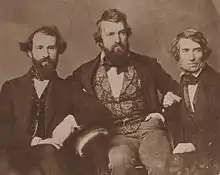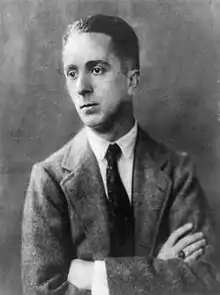National Academy of Design
The National Academy of Design is an honorary association of American artists, founded in New York City in 1825 by Samuel Morse, Asher Durand, Thomas Cole, Martin E. Thompson, Charles Cushing Wright, Ithiel Town, and others "to promote the fine arts in America through instruction and exhibition."[1] Membership is limited to 450 American artists and architects, who are elected by their peers on the basis of recognized excellence.
.jpg.webp) Current Building | |
| Formation | 1863 |
|---|---|
| Type | Honorary organization, museum, and school |
| Purpose | To promote the fine arts in America through instruction and exhibition |
| Headquarters | Manhattan, New York City |
| Location | |
President | Wendy Evans Joseph, NA |
| Website | http://www.nationalacademy.org |
History
.jpg.webp)
The original founders of the National Academy of Design were students of the American Academy of the Fine Arts. However, by 1825 the students of the American Academy felt a lack of support for teaching from the academy, its board composed of merchants, lawyers, and physicians, and from its unsympathetic president, the painter John Trumbull.
Samuel Morse and other students set about forming "the drawing association", to meet several times each week for the study of the art of design. Still, the association was viewed as a dependent organization of the American Academy, from which they felt neglected. An attempt was made to reconcile differences and maintain a single academy by appointing six of the artists from the association as directors of the American Academy. When four of the nominees were not elected, however, the frustrated artists resolved to form a new academy and the National Academy of Design was born.[2]
Morse had been a student at the Royal Academy in London and emulated its structure and goals for the National Academy of Design. The mission of the academy, from its foundation, was to "promote the fine arts in America through exhibition and education."[3]
In 2015, the Academy struggled with financial hardship. In the next few years, it closed its museum, severed ties to its art school, and sold much of its art collection and two of its buildings. The academy re-calibrated its core mission to focus on its living members.[4]
According to the Academy its 450 National Academicians "are professional artists and architects who are elected to membership by their peers annually."[5]
Official names
After three years and some tentative names, in 1828 the academy found its longstanding name "National Academy of Design", under which it was known for one and a half centuries. In 1997, newly appointed director Annette Blaugrund rebranded the institution as the "National Academy Museum and School of Fine Art", to reflect "a new spirit of integration incorporating the association of artists, museum, and school", and to avoid confusion with the now differently understood term "design".[6] This change was reversed in 2017.[3]
- 1825 The New York Drawing Association
- 1826 The National Academy of The Arts of Design
- 1828 The National Academy of Design
- 1997 The National Academy Museum and School of Fine Art
- 2017 The National Academy of Design
Locations
The Academy occupied several locations in Manhattan over the years. Notable among them was a building on Park Avenue and 23rd Street designed by architect P. B. Wight and built 1863–1865 in a Venetian Gothic style modeled on the Doge's Palace in Venice. Another location was at West 109th Street and Amsterdam Avenue.[7] From 1906 to 1941, the Academy occupied the American Fine Arts Society building at 215 West 57th Street.[8]
Since 1942 the academy has occupied a mansion at Fifth Avenue and Eighty-ninth Street,[9] the former home of sculptor Anna Hyatt Huntington and philanthropist Archer M. Huntington, who donated the house in 1940.[10]
Organization and activities
.jpg.webp)
The academy is a professional honorary organization, with a school and a museum.
One cannot apply for membership, which since 1994, after many changes in numbers, is limited to 450 American artists and architects. Instead, members are elected by their peers on the basis of recognized excellence. Full members of the National Academy are identified by the post-nominal "NA" (National Academician), associates by "ANA".[11]
The school offers studio instruction, master classes, intensive critiques, various workshops, and lunchtime lectures. Scholarships are available. The museum houses a public collection of over 7,000 works of American art from the 19th, 20th, and 21st centuries.
As of November 2018 the academy's Board of Governors consists of 18 board members, with Bruce Fowle as President (since 2010) and James Siena as Chairman of the Abbey Council.[12] Maura Reilly serves as Executive Director since 2015.[13]
Notable instructors
Among the teaching staff were numerous artists, including Will Hicok Low, who taught from 1889 to 1892. Another was Charles Louis Hinton, whose long tenure started in 1901. The famous American poet William Cullen Bryant also gave lectures. Architect Alexander Jackson Davis taught at the academy. Painter Lemuel Wilmarth was the first full-time instructor.[14] Silas Dustin was a curator.[15]
Notable members


Some of the Academy's better-known members include:
- Marina Abramovic
- Benjamin Abramowitz
- James Henry Beard
- Edwin Blashfield
- William Jay Bolton
- Lee Bontecou
- Stanley Boxer
- John F. Carlson
- Vija Celmins
- William Merritt Chase
- Frederic Edwin Church
- Chuck Close
- Thomas Cole
- Colin Campbell Cooper
- Leon Dabo
- William Parsons Winchester Dana
- Charles Harold Davis
- Henry Golden Dearth
- Jose de Creeft
- Richard Diebenkorn
- William Henry Drake
- Thomas Eakins
- Lydia Field Emmet
- Herbert Ferber
- Helen Frankenthaler
- Daniel Chester French
- Frederick Carl Frieseke
- Bruce Fowle
- Sonia Gechtoff
- Frank Gehry
- Paul Georges
- Arthur Hill Gilbert
- Hardie Gramatky
- Horatio Greenough
- Red Grooms
- Armin Hansen
- L. Birge Harrison
- Edward Lamson Henry
- Itshak Holtz
- Winslow Homer
- Cecil de Blaquiere Howard
- George Inness
- Jasper Johns
- Frank Tenney Johnson
- Lester Johnson
- Wolf Kahn
- Charles Keck
- Ellsworth Kelly
- Everett Raymond Kinstler
- Greta Kempton
- Chaim Koppelman
- Leo Lentelli
- Emanuel Leutze
- Hayley Lever
- Maya Lin
- Frank Lobdell
- Evelyn Beatrice Longman
- Frederick William Macmonnies
- Knox Martin
- Jervis McEntee
- Michael Mazur
- Gari Melchers
- Alme Meyvis
- Raoul Middleman
- F. Luis Mora
- Henry Siddons Mowbray
- John Mulvany
- David Dalhoff Neal
- Victor Nehlig
- Eliot Noyes
- Kate Orff
- Judy Pfaff
- Renzo Piano
- John Portman
- Cindy Sherman
- Carrie Mae Weems[16]
- Tom Otterness
- William Page
- Philip Pearlstein
- I. M. Pei
- John Thomas Peele
- William Lamb Picknell
- Albin Polasek
- Alfred Easton Poor
- Alexander Phimister Proctor
- Harvey Quaytman
- Andrew Raftery
- Robert Rauschenberg
- William Guy Wall
- Benjamin Franklin Reinhart
- Paul Resika
- Priscilla Roberts
- Dorothea Rockburne
- Norman Rockwell
- Mario Romañach
- Robert Ryman
- Augustus Saint-Gaudens
- Eugene Francis Savage
- John Singer Sargent
- Emily Maria Scott
- Richard Serra
- Hughie Lee-Smith
- Susan Louise Shatter
- Elliott Fitch Shepard
- Rhoda Sherbell
- William Siegel
- Nancy Spero
- Frederic Dorr Steele
- Frank Stella
- Arthur Fitzwilliam Tait
- Katharine Lamb Tait
- Jesse Talbot
- Reuben Tam
- Henry Ossawa Tanner
- Edmund C. Tarbell
- Louis Comfort Tiffany
- Cy Twombly
- Edward Charles Volkert
- Robert Vonnoh
- John Quincy Adams Ward
- Harry Watrous
- Frank Lloyd Wright
- Stow Wengenroth
- Frederic Whitaker
- Anita Willets-Burnham
- Dorothy Weir Young
- Milford Zornes
See also
- American Watercolor Society (located within the National Academy of Design)[17]
- Effects of the financial crisis of 2007–2009 on museums
- List of museums and cultural institutions in New York City
References
- "Charles Cushing Wright (1796-1854)". Retrieved August 14, 2017.
- Dunlap, William (1918). A History of the Rise and Progress of the Arts of Design in the United States (Vol. 3). C. E. Goodspeed & Co. pp. 52–57. Retrieved February 17, 2008.
- Historical Overview, National Academy of Design.
- Allen, Brian T (January 5, 2019). "The National Academy of Design Makes a Triumphant Comeback". National Review. Retrieved March 19, 2020.
It has always been an artist-run organization. Its exclusive, invite-only membership comprises many of the best artists in the country, and going forward it has decided to focus its resources and energy on serving them. This means promoting their achievements, helping them through grants, and producing a snappy online journal that’s fresh and focused.
- National Academicians, National Academy of Design.
- Annette Blaugrund as quoted in Traditional Fine Arts Organization, News: National Academy Clarifies Identity with Change of Name and New Visual Identity.
- Cassell, Dewey, with Aaron Sultan and Mike Gartland. The Art of George Tuska (TwoMorrows Publishing, 2005), ISBN 978-1-893905-40-5, p. 10
- asllinea.org https://asllinea.org/american-fine-arts-society-building/. Retrieved December 6, 2020. Missing or empty
|title=(help) - "Art of Past Era to Be Exhibited; National Academy of Design Opens New Home Jan. 1". The New York Times. October 5, 1941. ISSN 0362-4331. Retrieved December 6, 2020.
- The New York Times, January 11, 1998
- Artist Membership, National Academy of Design
- NAD Board
- NAD, Biography of Reilly
- History of the School Archived July 6, 2009, at the Wayback Machine
- "Painting by Dustin". fineart.ha.com. Retrieved October 19, 2010.
- Board of Governors. "National Academicians". The National Academy. Archived from the original on 16 January 2014. Retrieved 22 January 2014.
- Erin Corley (2007). "American Watercolor Society records, 1867-1977, bulk 1950-1970". Archives of American Art Oral History Program. Retrieved June 17, 2011.
External links
| Wikimedia Commons has media related to National Academy of Design. |
